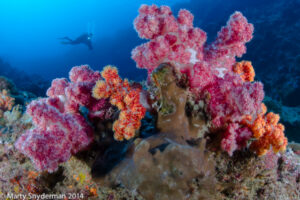
It makes perfect sense that underwater photographers want to create images with colorful subjects surrounded by inviting blue water. After all, that is the way the tropical ocean so often looks to our eyes when we dive, and the reason that many of us pay the big bucks to travel to destinations that are not in our own backyards.
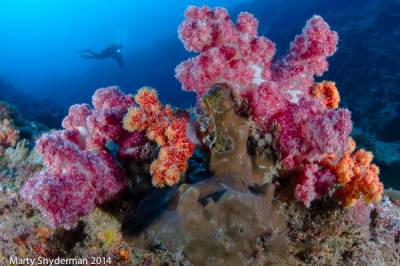
What sometimes fools us, especially relatively new underwater shooters, is that so often those colors that we remember as being so vivid underwater appear flat and drab in our photographs. What gives?
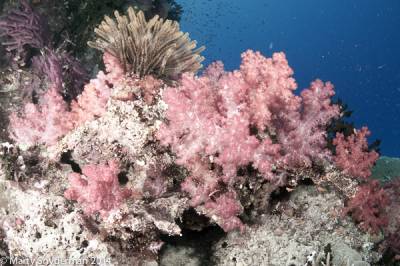
The answer is straightforward. Underwater our brain makes some adjustments because we have some understanding about what we are “supposed to see” or think we “will see”. In essence, our brains punch up (make warmer and more vivid) colors to allow us to see what we think we should. On the other hand, our cameras simply record the scene and the colors in front of them.
As underwater photographers we overcome this potential problem and add the desired color by using a strobe and getting close to the subjects in our foregrounds. In essence, light supplied by your strobe paints otherwise muted colors back into elements in the foreground of your photographs.
The point I want to be perfectly clear about here is that strobes only impact the appearance of elements in the foregrounds of your photographs. For a strobe to add light for exposure and otherwise lost colors (especially those hues from the red end of the visible spectrum of light) back into foreground subjects your strobe absolutely must be no farther away from your subject than 8 feet. And depending upon your camera settings there are a lot of times when 8 feet is way to far away.
Getting closer than 8 feet to your subject with your strobe is always better.
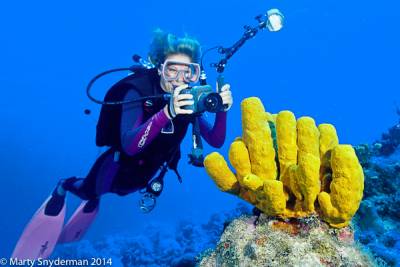
Light from the sun and your camera settings are what determines the look of the backgrounds in photographs that share an inviting blue or green water background.
So, properly exposing and revealing colors and detail in subjects that very large and/or farther away than 8 feet is totally dependent upon light from the sun and your camera settings. Your strobe can’t do a darn thing to help you in those situations!
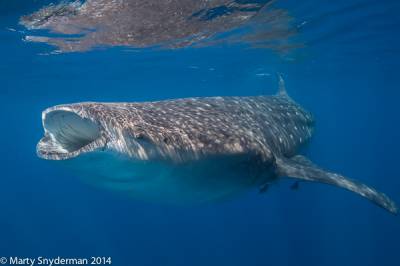
I think that most photographers, even relatively new underwater shooters, understand this concept ….. on land. But when they get underwater they so badly want their images to jump off the screens of their computers that they use their strobes when subjects are too far away for their strobe to do any good. And they just hope for a miracle that never occurs.
At least that miracle doesn’t occur without some help. And that help comes when they get close enough to their subject for their strobe to have an impact. That is 8 feet, or closer!
The fact is, creating images with colorful, strobe lit, foreground subjects and properly exposed, blue water backgrounds are the most difficult types of photographs for underwater shooters to expose properly. That’s because the photographer needs to coordinate the brightness of sunlight with the brightness of the light emitted by their strobe that strikes their foreground subject. Accomplishing that requires some advanced understanding and skill.
What you want to realize is that the exposure in this photograph of a pod of Atlantic spotted dolphins depended upon the brightness of the sunlight provided by Mother Nature and my camera settings at the exact instant I captured the image. My subjects were too big and too far away for a strobe to have any impact.
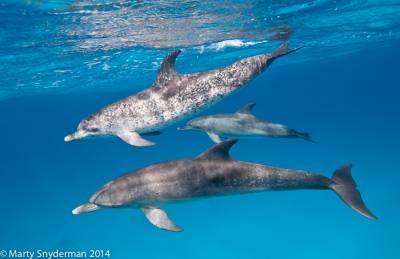
Conversely, in this photograph of a group of whitetip reef sharks resting in a cave, there was no sunlight to work with. That means that my exposure was totally dependent upon the power of my strobe, my strobe-to-subject distance, and my camera settings.
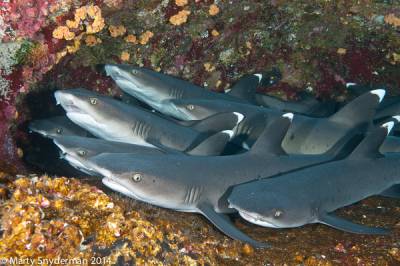
And then there are photographs like this one of a whitetip reef shark swimming in sea of blue. The exposure in this photograph depended upon coordinating the brightness of sunlight with the brightness of the light from my strobe that struck the shark. Getting all of this right is a learned skill that takes some time, patience, effort, and a willingness to learn from mistakes.
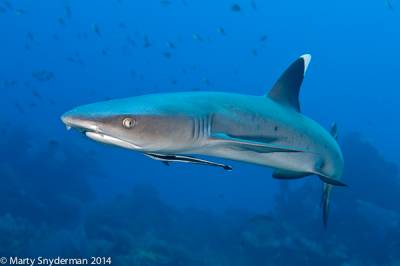
The main takeaway message from this piece is to understand that properly exposing background water and colorful, strobe lit, elements in the foreground is challenging for everyone. So, often as we begin taking pictures underwater we get the exposure of the background or foreground right, but we have a very hard time getting both exposures right. If that is happening to you; know that you are not alone, and with some understanding, practice and patience you can get it right too. Other have mastered this challenge, and so can you.
If you are a relatively new underwater photographer, or using a strobe is relatively new to you, you will probably enjoy more success and master your strobe faster if you start out by learning to consistently get proper exposures by composing frames that do not have blue water in the background. That is the case with the octopus photograph here:
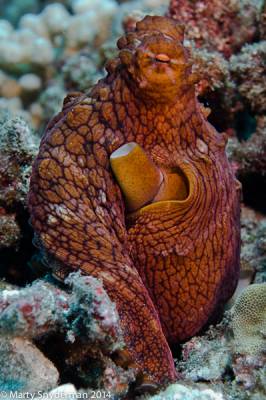
Shoot with the sea floor, a reef, even a distant reef, in the background, or at night when you first start using your strobe. Those shots will enable you to learn what you need to about your camera settings, the power settings of your strobe, and the importance of your strobe-to-subject distance.
After you feel confident about properly exposing photographs in these settings, then move on to trying to coordinate the use of your light meter (that is what is used to help you properly expose the water in the background of your shots) with your strobe.
I hope you enjoy and benefit from the information presented here, and we hope to see you back again on the 1st. If you did benefit from this blog, please tell a friend. Thank you,
0 0 1 899 5130 Chegg Deals 42 12 6017 14.0Normal 0 false false false EN-US JA X-NONE
Marty Snyderman For the Vivid-Pix Gang
